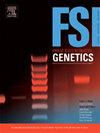DNA alloys: The enduring story of touch DNA on metals
IF 3.1
2区 医学
Q2 GENETICS & HEREDITY
引用次数: 0
Abstract
The successful analyses of DNA obtained from cellular deposits on metal substrates is an on-going issue with many metallic substrates inhibiting downstream enzymatic reactions. To examine this problem further, we report on the monitoring of persistence of cells deposited by touch on a range of metal surfaces using the DNA binding dye, Diamond Dye. Fingerprints were deposited in defined areas on metal substrates and stained with Diamond Dye. The cells were recorded at time points from initial deposition through to four weeks. Cells deposited on a glass microscope acted as a control. Little cell loss was recorded over the 4-week period on cells deposited on glass, nickel, stainless steel, and zinc. Unusual patterns of cell loss were recorded for cells deposited on copper and brass. Cells deposited on aluminium showed the greatest cell loss, nearly 22 %, contrasting with a loss of 4.5 % for cells deposited on glass (control). Whole thumbprints were deposited on the same substrates and stored for four weeks after which cellular material was removed using a swab and the DNA analysed using quantification and STR amplification. While cells deposited on copper did not record the greatest cell loss over the four weeks compared to the other metal substrates, when quantified and profiled, the whole thumbprints produced the least informative DNA profiles. No notable inhibition was recorded by qPCR for any sample, but degradation was indicated for both the brass and copper deposits. The data confirms that there are interactions between metallic surfaces and DNA and the substrate and DNA binding dye, which made cell visualisation difficult on brass and copper substrates. However, it also highlights that these metal-DNA interactions are causing DNA degradation on the copper and brass substrates that affect subsequent profile quality.
DNA合金:触摸DNA在金属上的持久故事
从金属底物的细胞沉积物中获得的DNA的成功分析是一个持续的问题,许多金属底物抑制下游酶促反应。为了进一步研究这个问题,我们报告了使用DNA结合染料钻石染料,通过触摸沉积在一系列金属表面上的细胞的持久性监测。指纹沉积在金属基材上的指定区域,并用金刚石染料染色。记录细胞从初始沉积到4周的时间点。放置在玻璃显微镜上的细胞作为对照。在4周的时间里,沉积在玻璃、镍、不锈钢和锌上的细胞几乎没有损失。沉积在铜和黄铜上的细胞有不同寻常的细胞损失模式。沉积在铝上的细胞损失最大,接近22% %,而沉积在玻璃(对照)上的细胞损失为4.5% %。将整个指纹沉积在相同的底物上并保存四周,之后用拭子去除细胞物质,并使用定量和STR扩增分析DNA。虽然与其他金属基质相比,沉积在铜上的细胞在四周内没有记录到最大的细胞损失,但当进行量化和分析时,整个指纹产生的DNA图谱信息最少。qPCR对任何样品均无明显抑制作用,但对黄铜和铜矿均有降解。数据证实,金属表面与DNA、底物和DNA结合染料之间存在相互作用,这使得在黄铜和铜底物上观察细胞变得困难。然而,它也强调了这些金属-DNA相互作用会导致铜和黄铜衬底上的DNA降解,从而影响随后的剖面质量。
本文章由计算机程序翻译,如有差异,请以英文原文为准。
求助全文
约1分钟内获得全文
求助全文
来源期刊
CiteScore
7.50
自引率
32.30%
发文量
132
审稿时长
11.3 weeks
期刊介绍:
Forensic Science International: Genetics is the premier journal in the field of Forensic Genetics. This branch of Forensic Science can be defined as the application of genetics to human and non-human material (in the sense of a science with the purpose of studying inherited characteristics for the analysis of inter- and intra-specific variations in populations) for the resolution of legal conflicts.
The scope of the journal includes:
Forensic applications of human polymorphism.
Testing of paternity and other family relationships, immigration cases, typing of biological stains and tissues from criminal casework, identification of human remains by DNA testing methodologies.
Description of human polymorphisms of forensic interest, with special interest in DNA polymorphisms.
Autosomal DNA polymorphisms, mini- and microsatellites (or short tandem repeats, STRs), single nucleotide polymorphisms (SNPs), X and Y chromosome polymorphisms, mtDNA polymorphisms, and any other type of DNA variation with potential forensic applications.
Non-human DNA polymorphisms for crime scene investigation.
Population genetics of human polymorphisms of forensic interest.
Population data, especially from DNA polymorphisms of interest for the solution of forensic problems.
DNA typing methodologies and strategies.
Biostatistical methods in forensic genetics.
Evaluation of DNA evidence in forensic problems (such as paternity or immigration cases, criminal casework, identification), classical and new statistical approaches.
Standards in forensic genetics.
Recommendations of regulatory bodies concerning methods, markers, interpretation or strategies or proposals for procedural or technical standards.
Quality control.
Quality control and quality assurance strategies, proficiency testing for DNA typing methodologies.
Criminal DNA databases.
Technical, legal and statistical issues.
General ethical and legal issues related to forensic genetics.

 求助内容:
求助内容: 应助结果提醒方式:
应助结果提醒方式:


